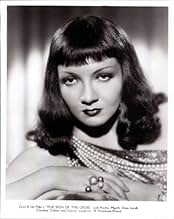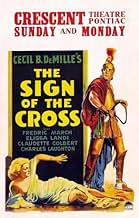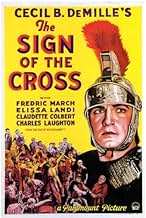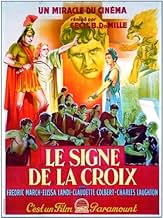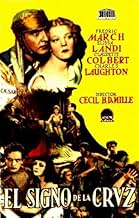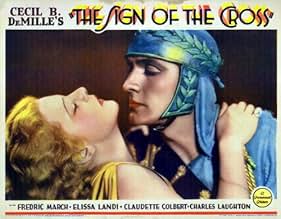VALUTAZIONE IMDb
6,8/10
2907
LA TUA VALUTAZIONE
Aggiungi una trama nella tua linguaA Roman soldier becomes torn between his love for a Christian woman and his loyalty to Emperor Nero.A Roman soldier becomes torn between his love for a Christian woman and his loyalty to Emperor Nero.A Roman soldier becomes torn between his love for a Christian woman and his loyalty to Emperor Nero.
- Regia
- Sceneggiatura
- Star
- Candidato a 1 Oscar
- 3 vittorie e 1 candidatura in totale
Joyzelle Joyner
- Ancaria
- (as Joyzelle)
Robert Seiter
- Philodemus
- (as Robert Manning)
Recensioni in evidenza
Hollywood legend has it that DeMille cast Claudette Colbert as Poppaea by asking her if she'd like to play the "wickedest woman in the world". Who could refuse an offer like that? There are already quite a few excellent (and fun) reviews in this column now, but in view of the DVD release I'd like to add a few things. This lavish picture shows DeMille at his best, worst, most decadent and most unusual. I first saw the expurgated World War II era re-release on TV ages ago, and wasn't much impressed. My father said they'd bowdlerized it a lot, so I was curious to see the 1932 original when it appeared on VHS a few years back. "Astound Me" Diaghilev once famously said to Cocteau; and astounded I was. I was expecting a lot more craziness, but I wasn't expecting to see elephants stepping on men's heads or naked women being eaten by crocodiles. Released in December 1932 it is marginally a pre-code movie, but surely only DeMille could have gotten away with it. This movie has nothing to do with Hollywood of the Thirties; this is Hollywood of the Twenties having one last outrageous fling, with all its sex, drugs, decadence, and all round insanity. The movie plays very much like a silent; perhaps it should have been a silent, thus sparing us its greatest defect, which is some of the worst dialog ever perpetrated. Fredric March as Marcus, the male lead, struggles manfully with awful lines throughout; but it is the visual aspect which dominates one's attention. Consider Colbert's legendary bath in a veritable swimming pool filled with milk (and she's really naked under all that milk). A friend, played by Vivian Tobin with kittenish glee, arrives; they exchange a few verbal barbs worthy of a pair of snarky teenagers, then Poppaea simply says "Take off your clothes. Get in here and tell me all about it." Anyone who thinks the naughty implications of this were inadvertent in innocent old 1932 hasn't spent much time in Hollywood Babylon, to say nothing of Hollywood Rome. Colbert is a delight throughout; her scenes with Fredric March play as high comedy. As he desperately tries to assert his nobility and self control, Colbert effortlessly demolishes his dignity with the perfect lazy grace of a leopardess. And let's not forget Charles Laughton, whose Nero is a masterpiece of omnisexual megalomania. Only Peter Ustinov in the 1951 "Quo Vadis" could better him.
This is on the surface a standard lions vs. Christians epic, but it ain't one to take your Sunday School class to. Under no circumstances should this be viewed by kids, even today. Much of the imagery is equivocal, to put it politely, especially during the big arena show that fills the last half hour. And then there's Marcus' big party, where Joyzelle Joyner performs a dance that is startlingly obscene for 1932.
All of this is ravishingly photographed by cameraman Karl Struss, one of the great artists of monochrome, who makes every shot a work of art. There is one scene in the house occupied by Mercia and her aged guardian, where the old man is seen in a hallway with a gate and small yard beyond; in the yard is an urn. The whole shot is lit by a single brilliant light blasting down on the urn, with bounce boards sending the light gently into the house. This violates all the rules of how to light a scene, but the effect is magical. A quick word should also be put in for Rudolph Kopp, who supplied the music (curiously uncredited); he actually has a go at recreating an authentic ancient Roman sound (no actual ancient Roman music survives).
But the core of the picture is the last part, the ultimate Roman circus. DeMille does something genuinely startling here. First he invites us, a little salaciously, to watch the spectacle, which begins with gladiatorial combat, but proceeds to darker and darker exhibits, many of which are genuinely disturbing (I wasn't kidding about the naked women and the crocodiles; wait until you see the Gaulish Amazon women vs. the Pygmies). As it gets more and more evil, we keep cutting to vivid closeups of the audience that we have been invited to join; some excited, some revolted, some merciless, some bored to distraction, some filled with pity, some sadistic, some almost drooling with voyeurism; they are us, and we are them. DeMille has had the effrontery to show us our own faces as we feast our eyes on all this exquisitely photographed mayhem. It's not easy to watch, and I know of nothing else quite like it prior to Stanley Kubrick.
This is on the surface a standard lions vs. Christians epic, but it ain't one to take your Sunday School class to. Under no circumstances should this be viewed by kids, even today. Much of the imagery is equivocal, to put it politely, especially during the big arena show that fills the last half hour. And then there's Marcus' big party, where Joyzelle Joyner performs a dance that is startlingly obscene for 1932.
All of this is ravishingly photographed by cameraman Karl Struss, one of the great artists of monochrome, who makes every shot a work of art. There is one scene in the house occupied by Mercia and her aged guardian, where the old man is seen in a hallway with a gate and small yard beyond; in the yard is an urn. The whole shot is lit by a single brilliant light blasting down on the urn, with bounce boards sending the light gently into the house. This violates all the rules of how to light a scene, but the effect is magical. A quick word should also be put in for Rudolph Kopp, who supplied the music (curiously uncredited); he actually has a go at recreating an authentic ancient Roman sound (no actual ancient Roman music survives).
But the core of the picture is the last part, the ultimate Roman circus. DeMille does something genuinely startling here. First he invites us, a little salaciously, to watch the spectacle, which begins with gladiatorial combat, but proceeds to darker and darker exhibits, many of which are genuinely disturbing (I wasn't kidding about the naked women and the crocodiles; wait until you see the Gaulish Amazon women vs. the Pygmies). As it gets more and more evil, we keep cutting to vivid closeups of the audience that we have been invited to join; some excited, some revolted, some merciless, some bored to distraction, some filled with pity, some sadistic, some almost drooling with voyeurism; they are us, and we are them. DeMille has had the effrontery to show us our own faces as we feast our eyes on all this exquisitely photographed mayhem. It's not easy to watch, and I know of nothing else quite like it prior to Stanley Kubrick.
Yikes! De Mille's erotic raunchy graphic and splendid SIGN OF THE CROSS made at Paramount in 1932, and his first talkie bible study is a movie you not forget. It is infamous and famous for many sights and other comments here will give you the reaction to the graphic cruelty of the truly shocking Arena/Gladiator scenes. The ridiculously entertaining asses milk bath with nipples ahoy and Claudette's milky breasts, the very funny dialog of daily life amid the splendor, the horror of the rape and torture of a teenage Christian boy, the eerie similarity to the 1932 German persecution of the European Jews, the depression era parable of the idle rich uncaring at the financial death of the 1930s masses, the dazzling costumes (no bras in Rome either), the claustrophobic street sets with rushing horses and fights in corners, all in all create an amazing action tableau like a pencil sketch bible book drawing brought to life. The film's art direction and set design and costumes are especially evocative of 'a silent epic with sound' and one easily can transfer the idea of seeing the 1925 BEN HUR with sound as SIGN OF THE CROSS favorably compares. The Arena montage scenes are really shocking. The Moon Dance is outrageous lesbian swankiness and gorgeous as all hell... well pagan hell as depicted by the morally austere Demille. Great moving wallpaper for your next party if played on a big TV and without sound with your CD collection going instead. If you agree that SIGN OF THE CROSS made in 1932 is really a 1920s silent film with dialog, have a look at FOLLOW THRU made two years earlier in 1929 and in color and as jazz modern today in it's creative style. CROSS plays like an ancient movie but FOLLOW THRU still plays new.
Cecil B. DeMille was famous for the excesses he depicted on screen, and "The Sign of the Cross" has enough excess for a dozen movies by any other director. Fortunately, DeMille loved to detail the debauchery that warranted divine punishment, because he was more adept and entertaining when portraying orgies than he was when depicting piety. Perhaps sin is intrinsically more interesting than virtue. Certainly the sinful characters, especially Charles Laughton as Nero and Claudette Colbert as Poppaea, are riveting and colorfully conceived. Laughton lolls around on his divans, while alluring slave boys attend to his whims. Colbert lures and tempts lovers when not catering to her bare flesh in a milk bath. Bloody gladiatorial games and the obligatory feeding Christians to the wild beasts keep the proceedings on track, and an erotic Lesbian dance enlivens an otherwise dragging orgiastic gathering. Orgies can be difficult to film because the delights are far more evident to participants than they are to viewers. Perhaps every orgy needs a Lesbian dance.
Unfortunately, DeMille felt compelled to throw away screen time on a group of early Christians, whose idea of a good time was to sit on rocks, sing tuneless songs, and listen to a motivational speaker. Naturally, the improbably named Marcus Superbus, played by Frederic March in a fetching mini-skirt and tight curls, falls in love with Mercia, a bland, but virginal, Elissa Landi, and he rejects the advances of the milky, silky Claudette Colbert, who had been around the Colosseum a few times. Of course, March not only rejects Colbert, but risks losing the endless parties and his own rising career for the touch of Landi's soft hand. "The Sign of the Cross" is hardly convincing drama despite the lure of Romans sinning every way, everywhere, and with everybody.
If the corny dialog and stilted scenes of pious proceedings had been severely cut and Laughton's and Colbert's roles had been brought to center focus, the film would have been a delicious camp spectacle. However, as the film now plays, viewers must patiently wait out the dull-as-drying-paint scenes with Landi and company to savor the sinful delights of Nero and Poppaea, which make "The Sign of the Cross" worth a look and a hoot or two.
Unfortunately, DeMille felt compelled to throw away screen time on a group of early Christians, whose idea of a good time was to sit on rocks, sing tuneless songs, and listen to a motivational speaker. Naturally, the improbably named Marcus Superbus, played by Frederic March in a fetching mini-skirt and tight curls, falls in love with Mercia, a bland, but virginal, Elissa Landi, and he rejects the advances of the milky, silky Claudette Colbert, who had been around the Colosseum a few times. Of course, March not only rejects Colbert, but risks losing the endless parties and his own rising career for the touch of Landi's soft hand. "The Sign of the Cross" is hardly convincing drama despite the lure of Romans sinning every way, everywhere, and with everybody.
If the corny dialog and stilted scenes of pious proceedings had been severely cut and Laughton's and Colbert's roles had been brought to center focus, the film would have been a delicious camp spectacle. However, as the film now plays, viewers must patiently wait out the dull-as-drying-paint scenes with Landi and company to savor the sinful delights of Nero and Poppaea, which make "The Sign of the Cross" worth a look and a hoot or two.
One of the very first and one of the very best Roman epics on screen filled with DeMille's splendor!
A comment on the original 1932 version.
Pagan Rome, the third night of the great fire. Emperor Nero (Charles Laughton) unjustly condemns Christians of burning the eternal city and sentences many of them to martyrdom. He does not realize that through this deed he unconsciously opens for them a wonderful glory in a better world. The struggle between the sign of the Roman eagle of decadent Nero's times and the sign of the cross begins, this is, symbolically, the endless struggle between those with "delicious debauchery" as the sole aim of life (the lifestyle Nero's times promoted) and those heading for everlasting virtues like love, piety, forgiveness, and purity of heart. Cecil B DeMille's THE SIGN OF THE CROSS, being the first sound biblical epic after his silent KING OF KINGS (1927) is, though more than 70 years old, a great spectacle, still one of the most entertaining Roman epics, except for QUO VADIS (1951), SPARTACUS (1960), and BEN HUR (1959).
GREAT CAST: The outstanding cast in the movie are its strongest point. Claudette Colbert's portrayal of wicked, lustful Poppaea is gorgeous. The same can be said about Charles Laughton who portrays Nero as a really decadent emperor, entirely flooded in debauchery and all sorts of sinful lusts. There have been more portrayals of this cruel pair (Poppeae and Nero), but theirs from DeMille's film is real feast for the soul. Therefore, they are even more memorable than Elissa Landi and Fredric March playing the main roles of Mercia and Marcus. Indeed, March as Marcus Superbus does a good job, especially in the way he shows a change of heart from a mocker to a believer. Elissa Landi presents Mercia's innocence and virtues memorably. But they are not that terrific as Colbert and Laughton. As far as performances are concerned, it is also important to mention Joyzelle as "the most wicked and talented woman in Rome", Ancaria. The scene of her seduction is truly well played. The dance of the Naked Moon that Ancaria seduces on Mercia is disturbed by Christians singing in a dungeon. MORAL MESSAGE: That scene clearly expresses the fact I have mentioned at the beginning: the universal struggle between two groups of people with two different aims in life. I think that DeMille also wanted to show this moral in another scene: the meeting of two old Christian men, Favius and Titus sent by Paul to Rome. One of them draws the sign of the cross on the ground, which is later trodden on by many people walking in the square.
SIMILARITY TO ANOTHER EPIC: A significant fact is that the content of the movie is strikingly similar to another Roman epic, made almost 20 years later, QUO VADIS (1951) by Mervyn LeRoy. While QUO VADIS is based on the novel by Henryk Sienkiewicz, this film is based on a play by an English playwright, Wilson Barrett. Both films, however, present the 1st century Rome, in particular, spreading Christianity in the cruel times of Nero; both films show the conversion of a Roman soldier Marcus who loves a Christian girl; both films remind us of the secret Christian meetings; both films focus on Poppaea being lustful for Marcus and demanding revenge on Christians because of jealousy (consider the moment Marcus Superbus comes to Nero to ask him to spare the life of Mercia. Nero says: If she would publicly renounce her faith... when Poppaea disturbs radically: "Not even then!") Moreover, both films show Poppaea's beautiful leopards. Finally, THE SIGN OF THE CROSS and QUO VADIS show the arena sequence, however DeMille presents much more of its gore than LeRoy in 1951.
ARENA: Alligators feeding with a young Christian woman, elephants treading on people's heads, a gorilla raping a girl tied to a wooden pillar, people crucified and burned, men fighting with bulls, bears, women fighting with dwarfs; yet lions and tigers eating Christians, and many other cruel games to the joy and lust of the viewers. Indeed, it is a film not to be watched by kids even at the beginning of the 21 century, but historically accurate and visually very well made.
ONE OF CINEMA'S MOST MEMORABLE MOMENTS: Except for the cruel arena sequence, which is still entertaining in some way, any viewer will be surprised at one scene: Poppaea's famous milk bath. That's a moment that everyone should consider while watching the film. Her sexual bath is one of the best made moments that cinema has ever seen. It is totally filled with desire and sexuality. And all thanks to the great performance by Ms Colbert. No surprise Cecil B DeMille cast her to play Cleopatra two years later, in 1934.
It's difficult to express all I feel about this movie in one review. I simply tried my best to encourage everyone to see this movie because it was an unforgettable experience for me, one of the very best Roman epics of all time. If you have already seen QUO VADIS, you will find this movie very similar but, indeed, more DeMillean. The end is very much influenced by the 1930s cinema but very touching and universally true - the absolute victory always comes in the Sign of the Cross... 9/10
Pagan Rome, the third night of the great fire. Emperor Nero (Charles Laughton) unjustly condemns Christians of burning the eternal city and sentences many of them to martyrdom. He does not realize that through this deed he unconsciously opens for them a wonderful glory in a better world. The struggle between the sign of the Roman eagle of decadent Nero's times and the sign of the cross begins, this is, symbolically, the endless struggle between those with "delicious debauchery" as the sole aim of life (the lifestyle Nero's times promoted) and those heading for everlasting virtues like love, piety, forgiveness, and purity of heart. Cecil B DeMille's THE SIGN OF THE CROSS, being the first sound biblical epic after his silent KING OF KINGS (1927) is, though more than 70 years old, a great spectacle, still one of the most entertaining Roman epics, except for QUO VADIS (1951), SPARTACUS (1960), and BEN HUR (1959).
GREAT CAST: The outstanding cast in the movie are its strongest point. Claudette Colbert's portrayal of wicked, lustful Poppaea is gorgeous. The same can be said about Charles Laughton who portrays Nero as a really decadent emperor, entirely flooded in debauchery and all sorts of sinful lusts. There have been more portrayals of this cruel pair (Poppeae and Nero), but theirs from DeMille's film is real feast for the soul. Therefore, they are even more memorable than Elissa Landi and Fredric March playing the main roles of Mercia and Marcus. Indeed, March as Marcus Superbus does a good job, especially in the way he shows a change of heart from a mocker to a believer. Elissa Landi presents Mercia's innocence and virtues memorably. But they are not that terrific as Colbert and Laughton. As far as performances are concerned, it is also important to mention Joyzelle as "the most wicked and talented woman in Rome", Ancaria. The scene of her seduction is truly well played. The dance of the Naked Moon that Ancaria seduces on Mercia is disturbed by Christians singing in a dungeon. MORAL MESSAGE: That scene clearly expresses the fact I have mentioned at the beginning: the universal struggle between two groups of people with two different aims in life. I think that DeMille also wanted to show this moral in another scene: the meeting of two old Christian men, Favius and Titus sent by Paul to Rome. One of them draws the sign of the cross on the ground, which is later trodden on by many people walking in the square.
SIMILARITY TO ANOTHER EPIC: A significant fact is that the content of the movie is strikingly similar to another Roman epic, made almost 20 years later, QUO VADIS (1951) by Mervyn LeRoy. While QUO VADIS is based on the novel by Henryk Sienkiewicz, this film is based on a play by an English playwright, Wilson Barrett. Both films, however, present the 1st century Rome, in particular, spreading Christianity in the cruel times of Nero; both films show the conversion of a Roman soldier Marcus who loves a Christian girl; both films remind us of the secret Christian meetings; both films focus on Poppaea being lustful for Marcus and demanding revenge on Christians because of jealousy (consider the moment Marcus Superbus comes to Nero to ask him to spare the life of Mercia. Nero says: If she would publicly renounce her faith... when Poppaea disturbs radically: "Not even then!") Moreover, both films show Poppaea's beautiful leopards. Finally, THE SIGN OF THE CROSS and QUO VADIS show the arena sequence, however DeMille presents much more of its gore than LeRoy in 1951.
ARENA: Alligators feeding with a young Christian woman, elephants treading on people's heads, a gorilla raping a girl tied to a wooden pillar, people crucified and burned, men fighting with bulls, bears, women fighting with dwarfs; yet lions and tigers eating Christians, and many other cruel games to the joy and lust of the viewers. Indeed, it is a film not to be watched by kids even at the beginning of the 21 century, but historically accurate and visually very well made.
ONE OF CINEMA'S MOST MEMORABLE MOMENTS: Except for the cruel arena sequence, which is still entertaining in some way, any viewer will be surprised at one scene: Poppaea's famous milk bath. That's a moment that everyone should consider while watching the film. Her sexual bath is one of the best made moments that cinema has ever seen. It is totally filled with desire and sexuality. And all thanks to the great performance by Ms Colbert. No surprise Cecil B DeMille cast her to play Cleopatra two years later, in 1934.
It's difficult to express all I feel about this movie in one review. I simply tried my best to encourage everyone to see this movie because it was an unforgettable experience for me, one of the very best Roman epics of all time. If you have already seen QUO VADIS, you will find this movie very similar but, indeed, more DeMillean. The end is very much influenced by the 1930s cinema but very touching and universally true - the absolute victory always comes in the Sign of the Cross... 9/10
Believe it or not some sort of code did exist during the pre-Code era but no one felt obliged to follow it. Although lapped up by audiences the excesses on display in this extraordinary opus proved too much to bear in certain quarters and undeniably hastened the formation of the Hays Code and the crackpot Catholic League of Decency. One would hazard a guess that it is not so much the unspeakable cruelty depicted here that caused such moral outrage but the skimpy costumes and the hip-swivelling cooch dance by Joyzelle Joyner with its distinctly lesbian overtones.
Piety and Paganism are in direct opposition here and although Mr. De Mille is seen to be on the side of the angels he is astutely aware of the box office potential of depravity and debauchery.
What should really concern an objective cinéphile is how well-made the film is and how well it has held up over nine decades. The cinematography is lustrous courtesy of Karl Struss, one of the greatest pictorialists in the history of cinema whilst Mitchell Leisen's art and costume design is exemplary. The plot is not entirely original of course as the play by Wilson Barratt from which it is taken had been strongly influenced by the novel 'Quo Vadis?' of Henryk Sienkiewicz. Here the ill-fated lovers are played by Fredric March and Elissa Landi, both of whom do their very best in one-dimensional roles. The classy Miss Landi's portrayal is virtuous without being self-righteous and her anguished cry: "Dear Christ, why?" really touches the heart. A relatively small amount of screen time is allotted to Charles Laughton and Claudette Colbert as Nero and Poppaea but they certainly make the most of it. Miss Colbert is utterly bewitching here and supremely sensuous which makes her the obvious choice to play Cleopatra for the same director two years later. Apparently de Mille was perplexed by the idiosyncratic Mr. Laughton and gave up trying to direct him. Left to his own devices his performance is touched by genius and we are obliged to film historian David Thomson for describing Laughton's interpretation as 'the most flagrant and fleshy portrait of an abandoned homosexual spirit seen in a Hollywood film until that time.'
Although not for the faint hearted this piece is arguably Cecil B. De Mille's finest achievement.
Piety and Paganism are in direct opposition here and although Mr. De Mille is seen to be on the side of the angels he is astutely aware of the box office potential of depravity and debauchery.
What should really concern an objective cinéphile is how well-made the film is and how well it has held up over nine decades. The cinematography is lustrous courtesy of Karl Struss, one of the greatest pictorialists in the history of cinema whilst Mitchell Leisen's art and costume design is exemplary. The plot is not entirely original of course as the play by Wilson Barratt from which it is taken had been strongly influenced by the novel 'Quo Vadis?' of Henryk Sienkiewicz. Here the ill-fated lovers are played by Fredric March and Elissa Landi, both of whom do their very best in one-dimensional roles. The classy Miss Landi's portrayal is virtuous without being self-righteous and her anguished cry: "Dear Christ, why?" really touches the heart. A relatively small amount of screen time is allotted to Charles Laughton and Claudette Colbert as Nero and Poppaea but they certainly make the most of it. Miss Colbert is utterly bewitching here and supremely sensuous which makes her the obvious choice to play Cleopatra for the same director two years later. Apparently de Mille was perplexed by the idiosyncratic Mr. Laughton and gave up trying to direct him. Left to his own devices his performance is touched by genius and we are obliged to film historian David Thomson for describing Laughton's interpretation as 'the most flagrant and fleshy portrait of an abandoned homosexual spirit seen in a Hollywood film until that time.'
Although not for the faint hearted this piece is arguably Cecil B. De Mille's finest achievement.
Lo sapevi?
- QuizCecil B. DeMille was pressured to drop Ancaria's seductive dance in the orgy scene by Will H. Hays of the Hays Office, but DeMille adamantly refused. Still, censors often cut out gruesome parts of the film, particularly, the cart carrying dead bodies out of the arena, a gorilla dancing around a semi-nude girl, elephants stomping Christians and picking them up with their tusks, crocodiles about to eat a bound girl, etc. These scenes are all in the restored version.
- BlooperWe see a woman tied up in the Coliseum as crocodiles are set loose on her. They are clearly alligators (broad snout), which were unknown to Europeans until Columbus's time, 15 centuries later. Only two countries have alligators: The United States and China.The Romans never went to either place.
- Versioni alternativeRe-released in 1944, with some cuts (sex and sadism scenes) and preceded by a nine minute prologue, set in present time with a WWII theme. This re-release version runs 118 minutes.
- ConnessioniEdited into Through the Centuries (1933)
- Colonne sonoreChristian Hymn No.1
(1932) (uncredited)
Music and Lyrics by Rudolph G. Kopp
Sung a cappella by Christians at the meeting
Reprised by them after their capture and at the arena
Sung a cappella by Elissa Landi and Tommy Conlon
Played and sung offscreen at the end
I più visti
Accedi per valutare e creare un elenco di titoli salvati per ottenere consigli personalizzati
- How long is The Sign of the Cross?Powered by Alexa
Dettagli
Botteghino
- Lordo Stati Uniti e Canada
- 5.971.004 USD
- Tempo di esecuzione
- 2h 5min(125 min)
- Colore
- Proporzioni
- 1.37 : 1
Contribuisci a questa pagina
Suggerisci una modifica o aggiungi i contenuti mancanti


